The Ashtanga Yoga Tradition
Ashtanga Yoga is is the system of yoga originally taught by Sri K. Pattabhi Jois at the Ashtanga Yoga Institute in Mysore, India. It continues to be honored and taught today by his son Manju Pattabhi Jois, his daughter Saraswati, his grandson Sharath Rangaswamy or Sharaji, and every Ashtanga teacher and practitioner from all over the world. The method involves a set series of yoga postures that are linked together using the breath. It consists in a very energizing and therapeutic set of sequences that can be practiced and adapted by anyone and any stage of life with the guidance of a teacher.
It is a living lineage that dates back nearly five thousand years in a unbroken line of teachers, sages and gurus that reached millions of practitioners through the inspirational life of Sri K. Pattabhi Jois or Guruji (as he was known to his students) who passed away on May 18th, 2009. He was the founder of Ashtanga Yoga and of the Ashtanga Yoga Research Institute in Mysore, India (KPJAYI) where he dedicated his life to teaching the method to students from all over the world that came to study with him. A man of boundless energy, love and laughter, he taught until the age of 93
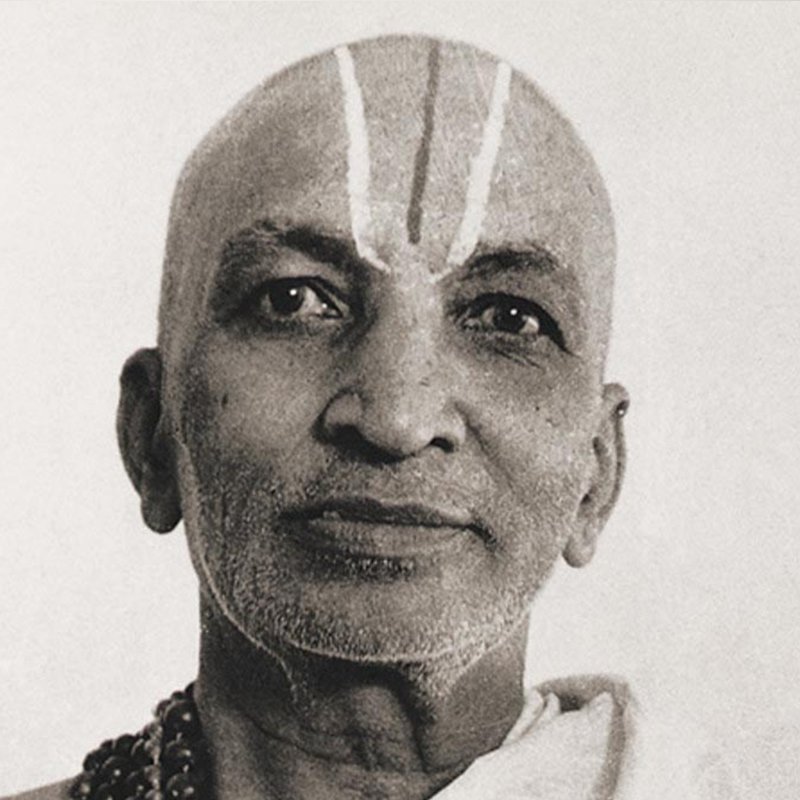
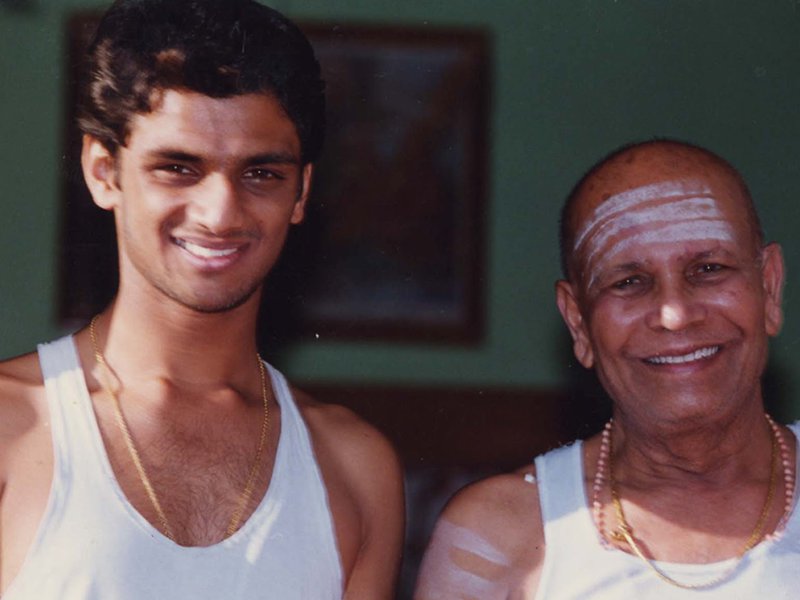
Developed by TKV Krishnamacharya and his student Sri Krishna Pattabhi Jois who taught us that Ashtanga yoga was derived from the ancient indian text, the Yoga Kurunta, written by Vamana Rishi. Krishnamacharya was one of the world’s most legendary masters of yoga. He was initiated into the science of Yoga by his Guru, Rama Mohan Brahmachari. Among Krishnamacharya’s students we find TKV Desikachar (his son), BKS Iyengar and Indra Devi along side Jois who studied with him from 1927 and into the 1950’s. Jois, or Guruji, continued the lineage of these teachings in Mysore, India and all around the world and it is through his lifelong dedication that we have the gift of Ashtanga yoga.
Ashtanga Yoga is the original vinyasa flow system from which power yoga, and other vinyasa flow classes have drawn their influences. Through the efforts of Sri K. Pattabhi Jois, the Ashtanga teachings have been preserved and are accessible in their authentic form through the legacy of his family and the numerous authorized and certified teachers that keep the teachings alive around the world.
The Practice
The method involves a set series of yoga postures that are linked together using the breath.
The Tristana Method:
"Tri" means three in Sanskrit and "sthana" means place or land. This method consists of the breathing technique of Ujjayi pranayama, the postures (including the use of energetic body locks or bandhas), and the focal point of each posture (drsti). Practitioners, through this method, develop control of their senses and a deep awareness of themselves and their inner sensations, emotions, and activities and mental work.
Breathing (ujjayi):
This is the basis for the internal forms of practice. Breath is life. It gives life to the postures and, through good breathing, we can control our mental states and cultivate our vital energy (Prana) to live a more abundant life.
Breathing unites the body and mind, and combined with the practice of asanas becomes the portal to meditation that has the power to bless you with a life of mental clarity, peace and joy.
We begin with the ujjayi breathing that serves as the basis of practice.
Posture (asana)
The postures, called asanas, are three main groups of sequences of movement and six series in total: The Primary Series, Yoga Chikitsa, cleans and tones especially the physical body. The Intermediate Series, Nadi Shodhana, purifies the nervous system, opening up more subtle experiences of our energies and mind. Sthira Bhaga, Advanced Series A, B, C and D, literally means strength and grace, which further explores flexibility, vigor and tranquility as an integrated synergy, which requires greater levels of humility and dedication. Each set of postures must be done before moving on to the next. The practice is cumulative and it is essential to meticulously follow the order of the postures (asanas) as each individual asana builds on the previous one and prepares the professionals for the next one. The sequential process of learning Ashtanga Yoga allows its practitioners to develop the concentration, strength, flexibility and endurance needed to progress.
In a safe and balanced way. Each asana, or group of asanas, has a specific effect that is countered with the previous asana, or group of asanas.
Observation point (drsti)
Drsti means observation point. There are nine drstis in the practice of asanas. Drsti improves concentration and causes the unit to perform during practice. With our eyes focused on a place during our practice, we can be more present in the positions. This approach and awareness can lead to our daily life.
The nine drstis in ashtanga yoga:
- Urdhve drsti: Up to space
- Brumadhye drsti: third eye
- Nasagre drsti: tip of the nose.
- Parsvayoh drsti: right side
- Parsvayoh drsti: left side
- Nabhou drsti: Navel
- Hastagre drsti: tip of the middle finger.
- Angusthagre drsti: tip of the thumb
- Padagre drsti: tip of the big toe
Vinyasa system
The postures are linked together through the movement that flows (vinyasa). Vinyasa means the flow of the breath synchronized with the movement.
The purpose of vinyasa is for internal cleansing. Breathing and moving together while performing the asanas causes the blood to warm up, or as Guruji said, "blood boils." The thick blood is dirty and impure, causing diseases in the body. The heat created from vinyasa cleans the blood and makes it thin, so that it can circulate freely. When there is a lack of circulation, pain occurs. The combination of the asanas with movement and breathing, makes the blood circulate freely around all joints, eliminating body aches. Warm blood also moves through all internal organs eliminating impurities and diseases, which are released from the body by the heat that occurs during practice. Once the body is purified, it is possible to purify the nervous system and sensory organs, which requires many years of practice.
The result is a light and strong body, and a clear and stable mind.
8 limbs of Yoga “Ashtanga Yoga”
Ashtou means eight and anga means limb.
Compiled by the Patangili Sage in the Yoga Sutras, the 8 limbs are a progressive series of steps or disciplines that purify the body and mind, and ultimately lead the yogi to enlightenment.
The eight branches support each other and must be learned and taken to the daily action committed.
Yoga Sutra 2.28
By practicing the eight limbs of Ashtanga yoga, the impurities of the body and mind will be destroyed. These impurities are obstacles that prevent us from realizing the true nature of the soul.
Once these obstacles are clear when practicing the eight limbs of yoga, true wisdom (jnana) is understood and will shine. Only then can we distinguish between what is true and what is false.
The eight limbs are described by Patanjali as:
Yama (ethical discipline):
ahimsa (nonviolence),
satya (veracity),
asteya (do not steal),
brahmacharya (abstaining from sexual indulgence),
aparigraha (detachment).
Niyama (observation and purification):
sauca (cleaning, purity),
santosha (satisfaction),
tapah (austerity),
svadhyaya (study towards self-knowledge),
ishwara-pranidhana (surrender to God / be superior).
Asana (postures)
Pranayama (control of breathing)
Pratyahara (withdrawal of meaning)
Dharana (concentration)
Dhyana (meditation)
Samadhi (consciousness itself)
These days, the term "Ashtanga Yoga" is commonly used to describe the method taught by Pattabhi Jois.
Parampara:
It is knowledge that is passed in succession from teacher to student. It is a Sanskrit word that denotes the principle of transmitting knowledge in its most valuable form; knowledge based on direct and practical experience. It is the basis of any lineage: the teacher and student form the links in the chain of instruction that has been passed down for thousands of years. Knowledge can be transferred only after the student has spent many years with an experienced guru. This transfer from teacher to student is parampara.
The dharma, or duty, of the student is to practice diligently and to strive to understand the teachings of the guru. The perfection of knowledge – and of yoga — lies beyond simply mastering the practice; knowledge grows from the mutual love and respect between student and teacher, a relationship that can only be cultivated over time.
The teacher’s dharma is to teach yoga exactly as he learned it from his guru. The teaching should be presented with a good heart, with good purpose and with noble intentions. There should be an absence of harmful motivations. The teacher should not mislead the student in any way or veer from what he has been taught.

Opening Prayer
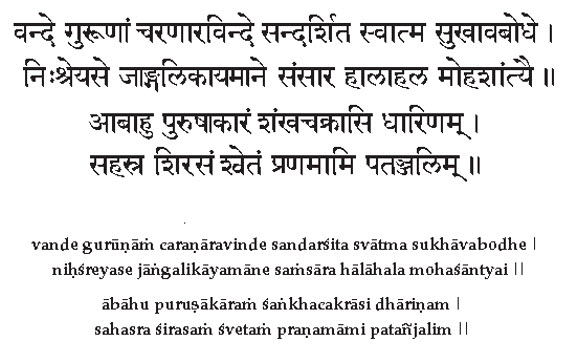
I bow to the lotus feet of the Gurus
The awakening happiness of one's own Self revealed,
Beyond better, acting like the Jungle physician,
Pacifying delusion, the poison of Samsara.
Taking the form of a man to the shoulders,
Holding a conch, a discus, and a sword,
One thousand heads white,
To Patanjali, I salute.
Closing Prayer
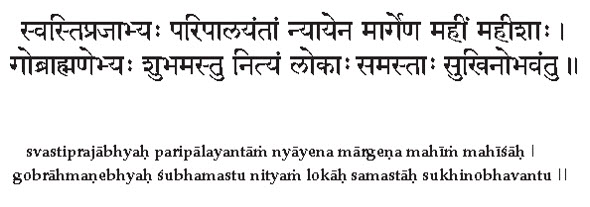
May all be well with mankind.
May the leaders of the earth protect in every way by keeping to the right path.
May there be goodness for those who know the earth to be sacred.
May all the worlds be happy.
About us
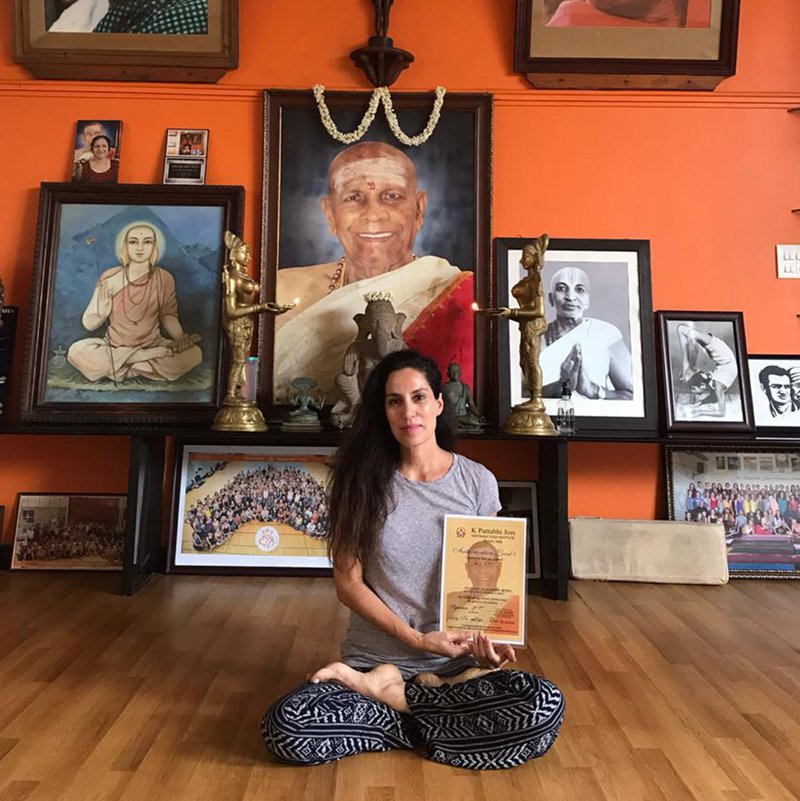
Patricia Echevarria
With Ashtanga Yoga I discovered the focus of my own body, and the work of the mind, as well as the internal aspect implied by its practice. I have practiced with teachers of wide trajectory in different places of the world such as Tim Miller, Tim Feldman, Manju Jois, Nancy Gigloff, Eileen Hall, David Swanson, Dany Paradise, among others. In September 2014 I made my first trip to the city of Mysore in India to be able to approach the Ashtanga fountain and I practiced with my Paramgurú R. Sharat Jois, who continues transmitting the legacy of his grandfather, Sri. K. Pattabhi Jois. After three years I received the blessing of being able to share what I had learned, with the Level I authorization given by my teacher Sharat Jois in 2018.
Ashtanga Yoga gives me balance, when I need tranquility. It is a tool because through the breath I reach physical and mental calm, allowing me to deal with life in a different way. It has helped me to know myself with the control of emotions, it awoke in me human aspects, I learn that first you have to develop love and compassion for yourself and then for others, generating awareness about everything that can happen around us.
Claudia Paredes
Yoga teacher with studies in Ashtanga, Vinyasa, Rocket, and Holistic Yoga; and Thai Massage Massage-Yoga.
I love movement, work with the body; and the consciousness that develops through working with the body and the breath to connect it with the mind and the spirit. That's why I live in love with Ashtanga Yoga and I travel constantly to northern India and Indonesia to continue my studies in tradition with my teacher Matthew Sweeney, to Mysore India to study with Ashtanga Guru Sharath Jois, where on my third trip (2018) I received his blessing to teach the method of Ashtanga Yoga as an authorized teacher in India and as originally taught in the Mysore Ashtanga style (Authorization Level 2), and to Thailand to continue my studies of Thai Yoga Massage and assist my teacher Andrea Baglioni.
Today, I live in Punta Hermosa Lima-Peru where I maintain a Yoga school focused on the traditional practice of Ashtanga Yoga, as well as the therapeutic and holistic aspect of the same tradition.

Write us
For more information about our projects and upcoming retreats do not hesitate to contact us using the form below or write to [email protected]. We have great projects for you.

